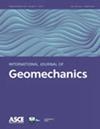Seepage–Creep Coupling Analysis of Concrete-Face Rockfill Dam Built on Alluvium Foundation
IF 3.3
2区 工程技术
Q2 ENGINEERING, GEOLOGICAL
引用次数: 0
Abstract
The foundation and dam body below the seepage-free surface are in a saturated seepage state for a concrete-face rockfill dam (CFRD) built on a deep alluvium foundation. The seepage and stress coupling effect could influence the dam deformation behavior. This study focuses on the seepage–creep coupling behavior of the CFRD on alluvium. The Drucker–Prager (D–P) plastic and time-hardening creep models are used to describe the instantaneous and creep deformations of rockfill and alluvium materials. The back propagation (BP) neural network method is adopted to invert the material creep model parameters. The dam and foundation seepage process is described using Signorini’s type variational inequality method. A seepage–creep coupling analysis method for CFRDs on alluvium is proposed on the basis of the momentum conservation principle and the Kozeny–Carman equation. The deformation mechanism and evolution process of CFRD on alluvium are investigated whilst considering the seepage–creep coupling effect. The influence of the seepage effect on the dam’ long-term deformation is discussed.冲积地基混凝土面板堆石坝渗流-徐变耦合分析
建在深冲积地基上的混凝土面板堆石坝,无渗水面以下的坝基和坝体均处于饱和渗流状态。渗流和应力耦合效应会影响坝体的变形行为。研究了冲积层上CFRD的渗流-蠕变耦合特性。采用Drucker-Prager (D-P)塑性和时间硬化蠕变模型来描述堆石料和冲积材料的瞬时和蠕变变形。采用反向传播(BP)神经网络方法反演材料蠕变模型参数。采用sigorini型变分不等式方法对坝基渗流过程进行了描述。基于动量守恒原理和Kozeny-Carman方程,提出了冲积层cfrd渗流-蠕变耦合分析方法。在考虑渗流-蠕变耦合效应的情况下,研究了CFRD在冲积层上的变形机理和演化过程。讨论了渗流效应对坝体长期变形的影响。
本文章由计算机程序翻译,如有差异,请以英文原文为准。
求助全文
约1分钟内获得全文
求助全文
来源期刊

International Journal of Geomechanics
ENGINEERING, GEOLOGICAL-
CiteScore
6.40
自引率
13.50%
发文量
374
期刊介绍:
The International Journal of Geomechanics (IJOG) focuses on geomechanics with emphasis on theoretical aspects, including computational and analytical methods and related validations. Applications of interdisciplinary topics such as geotechnical and geoenvironmental engineering, mining and geological engineering, rock and blasting engineering, underground structures, infrastructure and pavement engineering, petroleum engineering, engineering geophysics, offshore and marine geotechnology, geothermal energy, lunar and planetary engineering, and ice mechanics fall within the scope of the journal. Specific topics covered include numerical and analytical methods; constitutive modeling including elasticity, plasticity, creep, localization, fracture and instabilities; neural networks, expert systems, optimization and reliability; statics and dynamics of interacting structures and foundations; liquid and gas flow through geologic media, contaminant transport and groundwater problems; borehole stability, geohazards such as earthquakes, landslides and subsidence; soil/rock improvement; and the development of model validations using laboratory and field measurements.
 求助内容:
求助内容: 应助结果提醒方式:
应助结果提醒方式:


